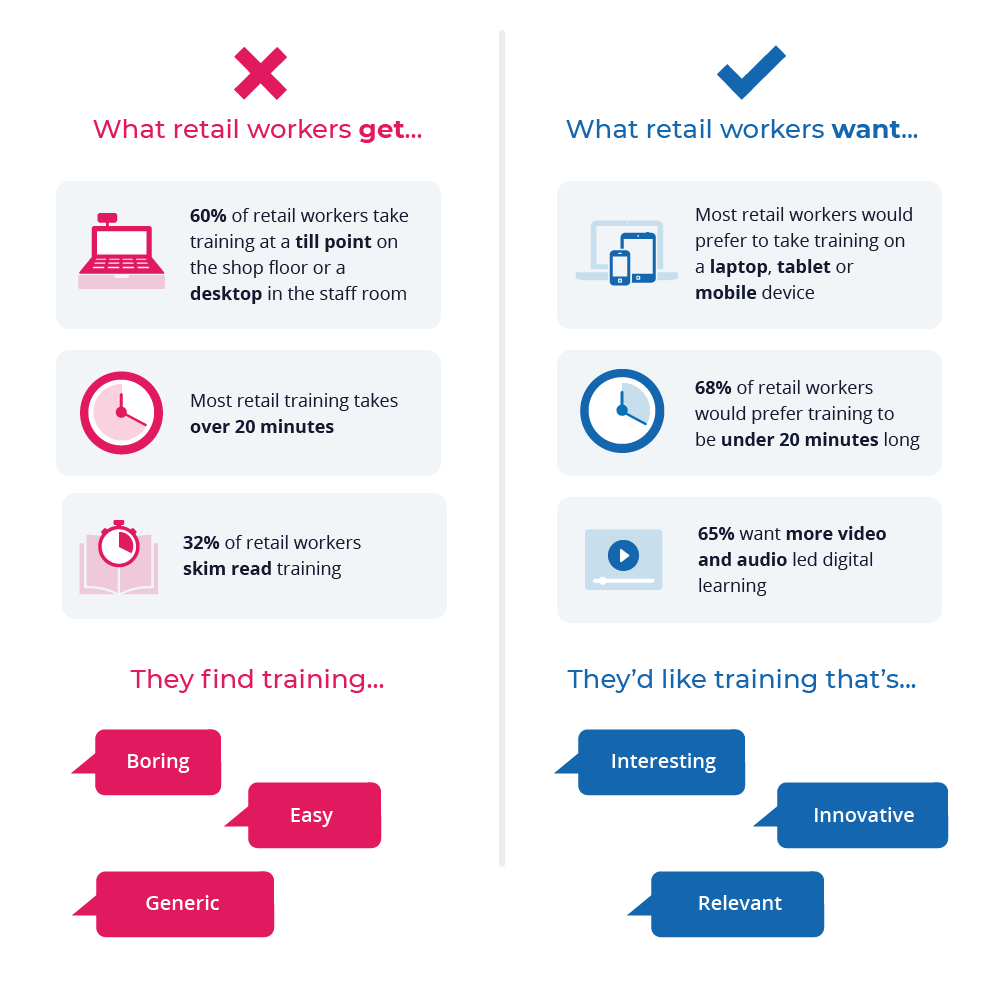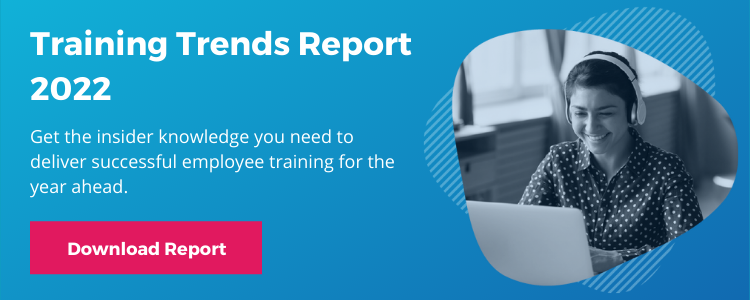Top challenges facing the retail industry, and how to overcome them
5 minute read
From fast-paced change to high employee turnover, retail has always faced unique challenges. However, the last few years has seen the pressure rapidly increase. With a record number of employees leaving and stores closing, it’s clear that retail has been struggling to adapt. If businesses are going to develop the skills they need to survive and thrive, L&D needs to take the lead. This article shares what retail L&D teams can do to get ahead.

Data overview
After another year of change and uncertainty, we wanted to find out what was really happening on the shop floor. We’ve surveyed the leaders who shape retail learning experiences, as well as the employees who complete the training. Speaking to over 25 L&D professionals and more than 800 learners uncovered some common challenges and opportunities for retail businesses.
Find out more about this research in our Training Trends Report 2022.
Biggest challenges facing the retail industry
The pandemic has transformed the way we live, work and – of course – shop. Changes that we’d seen coming for years suddenly accelerated and created three key challenges for retail.
-
Shifting consumer habits
According to Growth Engineering, 85% of today’s shoppers believe the pandemic has impacted how they shop. Online purchases have increased. Brand loyalty has decreased. While in-person retail experiences remain popular, shoppers’ expectations have changed. Whether online or in-store, they want seamless customer experiences. In fact, 86% of customers are willing to pay more for these
-
Increasing employee turnover
Retail businesses have always faced the challenge of high employee turnover. But the last few years have seen record numbers of people leave the industry. Filling all these vacancies has proved tricky.
McKinsey reports that 83% of retailers are struggling to recruit the right people. From the costs of hiring and training new people to the organization’s morale and productivity, turnover impacts everyone – individuals and teams, stores and businesses.
-
Emerging skill gaps
Whether it’s automated checkout lanes or Artificial Intelligence (AI) driven product recommendations, new technologies are transforming retail experiences. Regulations have been updated to protect consumers in this new retail landscape. But the skills needed to effectively support these innovations aren’t always present.
A McKinsey global survey highlights that nearly nine out of ten retail managers already see these skill gaps appearing or expect them to develop within the next five years.
What does that mean for retail learning teams?
L&D has been critical to helping retail businesses adapt to shifting customer demands and employee needs. Whether it’s onboarding the many new hires or upskilling employees on the latest tech and regulations, demand for digital learning has remained high. This is a challenge in itself. Over 80% of the L&D leaders we surveyed were struggling to:
- Respond at speed
- Manage stakeholders
- Maintain quality
And it doesn’t end once digital learning is produced. Getting learning in front of retail employees can be difficult. Any time off the shop floor and away from customers needs to be well spent. L&D teams are under pressure to make better use of learners’ time and deliver greater impact. With 40% of leaders highlighting a lack of investment or budget, it’s essential that L&D’s value can be demonstrated in stores.
What is the modern retail learner looking for?
Just under 80% of retail businesses deliver most of their training online. So, what do learners really think about these digital learning experiences?

Want to find out what learners across all sectors want from digital learning? Check out our secrets of corporate success.
What can retail learning teams do to get ahead?
Finding out what your employees want and need is the first step. Next, you have to turn these retail insights into effective learning experiences that deliver business impact. We’ve identified three digital learning trends that will help you do just that.
-
Harness the power of video
Retail employees are calling out for more video learning, so it’s no surprise this is a focus for 41% of learning leaders. Whether it’s sharing knowledge or telling customer stories, user-generated videos are a quick and easy way to get content out there. They also give your employees a voice and encourage peer learning.
Want to see some more video learning examples and other inspiration? Check out our retail staff training ideas.
-
Embrace microlearning
25% of L&D professionals said a microlearning approach worked best in their organization. Retail training content needs to be short and sharp so it can fit around work on busy shop floors. But don’t just focus on the time. Structure these self-guided microlearning journeys to make sure they have an impact.
Explore our microlearning strategies and examples to see what this could look like.
-
Make wellbeing a priority
The increased anxiety of the last few years has really hit retail workers. Our survey highlighted that employee mental health would be a major focus in 2022. But it’s not just about giving people the tools to better support their own wellbeing. It’s about putting people at the center of learning and development. That enables them to enjoy their work, progress in their careers and stay in the industry.
If you’re interested to see what other trends are emerging this year, check out the full corporate elearning trends article.
Summary
From employee retention to new skills gaps, retail faces many challenges in 2022. But, you can stay ahead by taking a people-centered approach.
- Find out what your employees really want and need
- Embrace microlearning and ensure it fits around work
- Provide the video learning your people want with user-generated content
- Focus on employee wellbeing to retain your retail talent
By putting your people at the center of L&D you can overcome retail’s key challenges and create value for your business and employees.
If you want to find out more about the latest trends, read our full Training Trends Report 2022.




